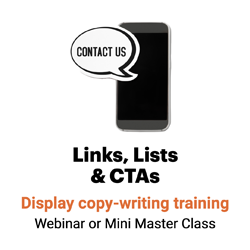Get to the point faster by putting the topic up top
When it comes to web heads, focus on the front.

That is, place your topic words at the beginning of your headline. That approach:
- Signals to Google what your page is about, improving your place on search engine results pages (SERPs)
- Helps readers decide to click your link on SERPS, indexes and other lists
How important is this? It’s the No. 1 thing you can do to improve the ROI of your website, says Jakob Nielsen, “king of usability.”
“Selecting the first 2 words for your page titles is probably the highest-impact ROI-boosting design decision you make in a web project, he says. “Front-loading important keywords trumps most other design considerations.”
How readers read indexes and lists online.
When viewing a list of articles on SERPs, index pages or other story lists, web visitors spend less than one second looking at headlines. That’s according to Eyetrack III, a study of online behavior by The Poynter Institute.
The same thing’s true of the summary blurbs or decks in the index listing.
“The first couple of words need to be real attention-getters if you want to capture eyes,” the researchers say.
Not so fast, says usability guru Jakob Nielsen. He estimates that visitors really scan more like the first 11 characters. What do the first 11 characters of your headlines tell potential readers?
- Use drop-down menus sparingly
- Beyond the Inverted Pyramid
- Drake University campus life
- Introducing Chase Exclusives Special Benefits for Checking Customers
- Don’t let your head get cut off
- How to Write the News Release 2.0
- Your Company Name announces
Make sure the first couple of words tell and sell — tell readers what your story is about and sell them on clicking. Here are 14 ways to do that:
1. Lead with the topic word.
Nielsen suggests that instead of:
Use drop-down menus sparingly
You try:
Drop-down menus: Use sparingly
2. Use the simple sentence structure.
Write subject, verb, object. That forces the subject — aka the topic — to the top. Instead of:
Beyond the Inverted Pyramid
Make it:
Feature stories boost readership
3. Move your organization’s name to the end.
Instead of:
Drake University campus life
Make it:
Campus life at Drake University
4. Make it a label head.
I know. This one makes me feel squeamish, too. It probably works better on a basic web content page than on a story or release:
Social media writing webinar
Nope, I still hate it.
5. Try the passive voice.
I hate this idea, too. But passive voice can help you front-load key words, Nielsen says. For instance:
Passive Voice Is Redeemed For Web Headings
Still hate that one, too.
6. Use plain language and specific terms.
In a test Nielsen ran of what visitors could learn from the first 11 letters of an index listing, this web head scored best:
Gift cards & E-Gift Certificates
7. Avoid marketing fluff.
In Nielsen’s 11-character test, this headline proved to be the least effective:
Introducing Chase Exclusives Special Benefits for Checking Customers
8. Use numerals.
Say more with fewer characters by using numerals, instead of spelling out numbers. Nielsen suggests that instead of:
First two words: A signal for the scanning eye
You make it:
First 2 words: A signal for the scanning eye
Note: AP Style supports this approach.
9. Skip leading articles.
Drop the “a,” “an” or “the.” Instead of:
The approval process syndrome …
Make it:
Approval process syndrome …
10. Consider promoting popular story forms up front.
Got a list or infographic? Consider investing some of your 11 characters in that:
Flowchart: Are you a troll or thought leader?
11. Use your deck in metatags.
At Wylie Communications, we like feature heads almost as much as we like Twix bars:
Don’t let your head get cut off
Web headlines must fit on mobile apps and more
So we’re experimenting with using our descriptive, front-loaded decks in metatags instead:
Web headlines must fit on mobile apps and more
12. Meet readers out front in page titles.
Using that approach, we cause the deck to show up on indexes and SERPs:
Web headlines must fit on mobile apps and more
Both feature head and descriptive deck both show up on content pages:
Don’t let your head get cut off
Web headlines must fit on mobile apps and more
13. Make the topic phrase a kicker.
Move the topic to the top as an additional layer of headline. Instead of:
How to Write the News Release 2.0
Make it:
News release 2.0 — Help Google find your site
14. Check your index pages.
How does your headline show up in SERPs, index pages and other story lists?
When you scan the list of headlines and links, what’s the first word in each item? Is it the topic word? Is it clear, specific and interesting?
For a “how not to” example of making copy list-ready, check out your organization’s index of press release headlines. Most bury the topic word behind:
Your Company Name announces …
How does yours stack up?
_____
Sources: Andy Bechtel, “Writing Headlines for Digital and Mobile Media,” Poynter News University, Dec. 5, 2013
Jakob Nielsen, “Company Name First in Microcontent? Sometimes!” Alertbox, March 3, 2008
Jakob Nielsen, “Passive Voice Is Redeemed For Web Headings,” Alertbox, Oct. 22, 2007

Leave a Reply